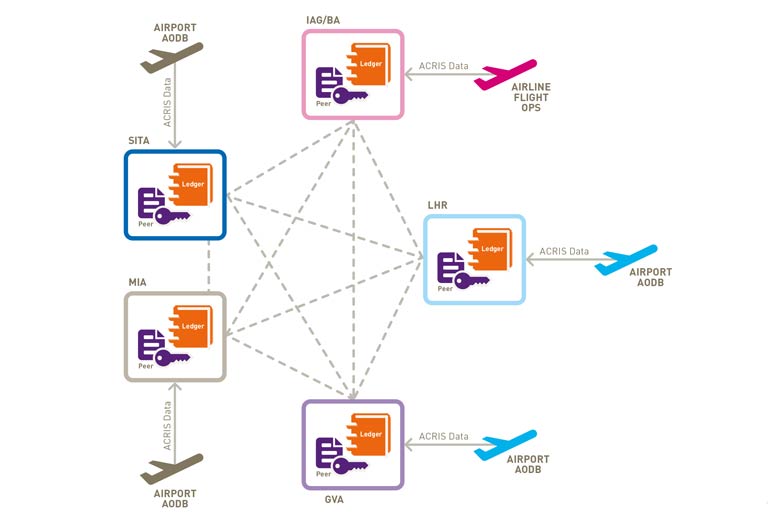The hype around blockchain technology and speculation about how it could be used in the air transport industry has created a lot of excitement and posed a number of as yet unanswered questions. Most airlines, airports, suppliers and other parties involved in the end-to-end air travel process seem to be aware that blockchain should be on their radar, but far fewer know exactly how it could impact their own business and the wider industry.
To help highlight a potential real-world application, a team comprising British Airways, Heathrow Airport, Geneva Airport, Miami International Airport and SITA Lab recently participated in a collaborative project to explore if and how blockchain technology can help to create a “single source of truth” for flight data. The flight data problem is a well-known issue in the industry – namely, there is no single source of the truth and the data that does exist, is not easily accessed by all parties.
While there are many cases of airlines and airports collaborating to share flight data, this data still resides in separate silos. When there are flight delays, this can result in different information being displayed on passenger apps and airport FIDS, for example. The FlightChain research project set out to ensure all stakeholders have access to the same, accurate information.
Proving the viability of blockchain
Discussing the project with FTE, Kevin O’Sullivan, Lead Engineer, SITA Lab, explained that FlightChain successfully demonstrated the viability of blockchain technology to provide a single source of truth for real-time flight data.
FlightChain was established as a private permissioned blockchain, implemented on both Ethereum and Hyperledger Fabric, and SITA Lab wrote a smart contract on the blockchain to arbitrate potentially conflicting data.

British Airways, Geneva Airport, Heathrow Airport and Miami International Airport were each granted permission to feed in live updates relating to certain stages of the journey. For example, the airline could update the flight data, the departure airport could update things like the departure gate, and the arrival airport could update information such as the arrival gate. This approach meant that all of the data on the blockchain network came from the most reliable source and was therefore as accurate as possible.
During the project more than 2 million flight changes were processed by the smart contract and stored on FlightChain. “This is just a proof of concept and future deployments would have to be a lot more sophisticated, but for now we’re proving that the basic technology works,” O’Sullivan said.
Blockchain obstacles
While the project has added to the feeling that blockchain has an important role to play in the future of the air transport industry, O’Sullivan explained that there are a number of hurdles to overcome. For example, various governmental, compliance and regulatory issues must be resolved. Also, industry-wide adoption of a smart contract in a blockchain network would essentially be “dictating a standard approach” for airlines and/or airports. With this in mind, oversight from the likes of ACI and IATA would be necessary.
“I can see that in the future, ACI and IATA standards documents could simply become smart contracts stored on the industry blockchain,” O’Sullivan suggested.
“Also, in a private blockchain there does need to be a level of governance, and that governance needs to be done by a trusted entity. If you can’t trust the person governing it, you can’t trust the data on the network. You’ve got to get the governance right without negating the benefits of blockchain.” This, he said, is another reason why buy-in from the likes of ACI and IATA is important.
Advice for airlines and airports
While blockchain technology clearly holds a great deal of potential, O’Sullivan warned that “it’s still really early days for the technology and there’s a lot of unanswered questions”. “What I keep saying to people is this reminds me an awful lot of the early ’90s when the internet came along and there was much hype about the internet and the world wide web, but nobody really understood it.
“Blockchain is still misunderstood, it’s being misapplied, start-ups are putting the word “blockchain” in their company name and doubling their valuation, and it’s a big echo chamber right now of everyone saying “blockchain is great, it’s going to fix everything”. You have to be careful.”
He continued: “The FlightChain research project was an effort to take a step back from all that hype and do something real; a real project with real airlines and airports, addressing a real problem, and seeing what we learn.”
O’Sullivan also had some valuable advice for airlines and airports who are considering stepping into the world of blockchain: they “should not bet the mortgage in the next 12 months” but “invest strategically in relevant use cases”, he advised. “You have to remember that this is a technology designed to solve problems with collaboration so there’s no point building a blockchain to address a data sharing issue when it’s just inside your own organisation.
“The larger the number of participants involved, the more value you can get out of blockchain. The more airlines and airports that participate in a particular use case, the greater the overall value to the industry.”






